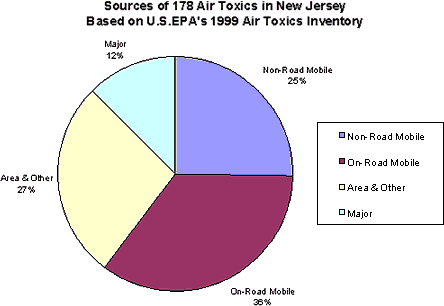Sources of Air Toxics – 1999 NATA
For the purposes of the National-scale Air Toxics Assessment (NATA), a point source is a stationary facility or process whose location could be identified with latitude and longitude coordinates. Point sources include large facilities that emit a significant amount of air pollution during manufacturing, power generation, heating, incineration, or other such activity. They also include smaller facilities including those that are required to report their emissions under the federal Toxic Release Inventory program and the state’s Community Right-To-Know program.
These are small stationary sources of air pollution which by themselves may not emit very much, but when their emissions are added together, they account for a significant portion of the total emissions of air toxics. They are also referred to as area sources and are generally too small or too numerous to be inventoried individually. The following are grouped under nonpoint sources in NATA:
- Consumer products, including personal care products, household products, adhesives and sealants, automotive products, and coatings such as paints
- Residential heating and fuel use
- Pesticide use
- Gasoline stations
- Dry cleaners
- Institutional and commercial heating
Mobile Sources are divided into two categories:
- On-road mobile sources are vehicles found on roads and highways, including cars, trucks, buses, and motorcycles.
- Non-road mobile sources include aircraft, trains, lawnmowers, boats, dirt bikes, construction vehicles, farm equipment, leaf blowers, and more.
THE NATIONAL AIR TOXICS EMISSIONS INVENTORY
As part of the National-Scale Air Toxics Assessment (NATA), USEPA prepared a comprehensive list of air toxics emissions for the entire country in 1999. The emissions inventory for New Jersey was briefly reviewed and revised by NJDEP before being finalized by USEPA. Although there are bound to be some errors in the details of a massive undertaking such as this, a summary of the emissions inventory can give us some indication of which may be the most important sources of air toxic emissions in our state. As can be seen from the pie chart below, mobile sources are the largest contributors to air toxics emissions in New Jersey, with on-road mobile sources accounting for 36%, and non-road mobile sources contributing 25%. Area sources represent 27% of the inventory. (USEPA refers to this category as “Area and Other” because it includes residential, commercial, and small industrial sources.) The remaining 12% of the inventory is attributable to major industrial sources. Major sources are defined by the Clean Air Act as facilities that emit more than 10 tons per year of a single hazardous air pollutant (HAP) or 25 tons per year of all HAPs combined.

COMPARISON OF EMISSIONS BY COUNTY
When the New Jersey emissions estimates are broken down by county, it is evident that the areas with the greatest air toxic emissions are generally those with the largest population. This is directly related to high levels of vehicle use, residential fuel burning, solvent use, and other population-related activities in those counties.

USEPA emphasizes that the methods used to conduct emissions inventories vary somewhat from year to year, so the results are not exactly comparable.
POLLUTANTS WITH SIGNIFICANT CONCENTRATIONS FROM BACKGROUND & TRANSFORMATION
Concentrations of some air toxics are dominated not by local emissions, but by atmospheric transformation (or secondary formation) and by what USEPA refers to as background estimates.
Secondary formation, or atmospheric transformation, occurs when chemicals are transformed into other chemicals in the atmosphere. When a chemical is transformed, the original pollutant no longer exists and is replaced by one or more new chemicals. A chemical that transformed from other pollutants can be more, less, or equally toxic to its precursors. Transformations and removal processes affect both the fate of a pollutant and its atmospheric persistence. EPA’s AirToxScreen uses secondary formation and atmospheric transformation interchangeably.
Formaldehyde is New Jersey’s primary air toxic of concern from secondary formation.
Background concentrations are existing levels of pollutants from natural sources, non-industrial human activities, and out of state industrial facilities. EPA describes background ambient air concentrations as values averaged over broad geographic regions. Background concentrations can account for pollutant concentrations found even without recent human-caused emissions.
Carbon tetrachloride is consistently considered an air toxic of concern in New Jersey, with estimated statewide average background concentrations exceeding the health benchmark.